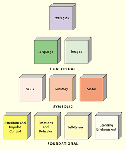Building Blocks of Learning
Excerpted and abridged from Chapter 1 of Learning Disabilities and Challenging Behaviors: A Guide to Intervention and Classroom Management, by Nancy Mather, Ph.D., & Sam Goldstein, Ph.D.
When a child struggles in school, teachers must first determine the underlying factors contributing to the learning or behavior problem. Similarly, when a child fails to or refuses to complete work, it is rarely because of poor motivation. Lowered motivation in students is often a secondary symptom, resulting from chronic school difficulties.
Over many years of working with students, psychologists, special education teachers, general education teachers, and parents, we have developed a simple framework for explaining why children experience learning and behavior problems in the classroom. We call this framework the Building Blocks of Learning, and it contains 10 building blocks stacked into the shape of a pyramid.
Foundational Blocks
Enlarge photo of Building Block Model by clicking on it

The foundational blocks provide the support system for all learning. Just as the foundation of a house must be strong enough to support the structure, these four blocks must be strong in order for learning to occur:
Attention and Impulse Control
This building block includes the abilities to pay attention and control impulses, abilities critical to all learning. The basis of some students' attention and behavior difficulties stem from poor self-regulation, and problems with impulse control can prevent students from focusing on the relevant requirements of classroom learning tasks. Some students have trouble maintaining persistent effort and are easily distracted when attempting to pursue a goal.
Emotions and Behavior
The building block of emotions and behavior includes the child's general temperament, as well as his or her moods. Conditions such as depression, anxiety and motivation can significantly affect a child's availability for learning. Difficulties in school also affect attitude and performance. For example, a student's difficulties with spelling can affect his or her attitude and willingness to persevere on tasks requiring writing.
Self-Esteem
The building block of self-esteem is related to how a child perceives him- or herself and to what factors he or she attributes successes and failures. These are learned attitudes, developed in part through feedback from parents, teachers, and peers. Poor academic self-esteem affects a child's willingness to persist on tasks until they are completed.
Learning Environment
The learning environment block includes the supports provided for the child in the home and school, as well as the types of services, such as speech-language or occupational therapy, that he or she receives. Although we know the home environment exerts a powerful influence on a child's school adjustment, our focus here is on the learning environment at school. Children with learning and behavior problems benefit from certain types of environments. For example, one student's lack of support coupled with the chaos at home were having a significant effect on his self-image and his emotional availability to engage in academic tasks. The teacher has a primary responsibility for creating a nurturing, supportive classroom environment.
To succeed in school, a child requires the ability to pay attention, healthy emotions, a positive view of self and school, and a supportive classroom environment. Strengths in the foundational blocks help a student compensate for other difficulties and learn to persevere even with difficult tasks. Weaknesses in the foundational blocks affect school performance, and adverse factors, such as a chaotic home environment or depression, reduce a child's availability for learning. Strong foundational blocks do not, however, guarantee school success.